Advertisements
Chapters
2: Exponents of Real Numbers
3: Rationalisation
4: Algebraic Identities
5: Factorisation of Algebraic Expressions
6: Factorisation of Polynomials
7: Linear Equations in Two Variables
8: Co-ordinate Geometry
9: Introduction to Euclid’s Geometry
10: Lines and Angles
11: Triangle and its Angles
12: Congruent Triangles
▶ 13: Quadrilaterals
14: Areas of Parallelograms and Triangles
15: Circles
16: Constructions
17: Heron’s Formula
18: Surface Areas and Volume of a Cuboid and Cube
19: Surface Areas and Volume of a Circular Cylinder
20: Surface Areas and Volume of A Right Circular Cone
21: Surface Areas and Volume of a Sphere
22: Tabular Representation of Statistical Data
23: Graphical Representation of Statistical Data
24: Measures of Central Tendency
25: Probability
![RD Sharma solutions for Mathematics [English] Class 9 chapter 13 - Quadrilaterals RD Sharma solutions for Mathematics [English] Class 9 chapter 13 - Quadrilaterals - Shaalaa.com](/images/8193647912-mathematics-english-class-9_6:1a030933ece146238cec338f12706a07.jpg)
Advertisements
Solutions for Chapter 13: Quadrilaterals
Below listed, you can find solutions for Chapter 13 of CBSE RD Sharma for Mathematics [English] Class 9.
RD Sharma solutions for Mathematics [English] Class 9 13 Quadrilaterals Exercise 13.1 [Page 4]
Three angles of a quadrilateral are respectively equal to 110°, 50° and 40°. Find its fourth angle
In a quadrilateral ABCD, the angles A, B, C and D are in the ratio 1 : 2 : 4 : 5. Find the measure of each angles of the quadrilateral
The angles of a quadrilateral are in the ratio 3 : 5 : 9 : 13 Find all the angles of the quadrilateral.
In a quadrilateral ABCD, CO and DO are the bisectors of `∠`C and ∠D respectively. Prove that
`∠`COD = `1/2` (`∠`A+ `∠`B).
RD Sharma solutions for Mathematics [English] Class 9 13 Quadrilaterals Exercise 13.2 [Pages 19 - 20]
Two opposite angles of a parallelogram are (3x – 2)° and (50 – x)°. Find the measure of each angle of the parallelogram .
If an angle of a parallelogram is two-third of its adjacent angle, find the angles of the parallelogram .
Find the measure of all the angles of a parallelogram, if one angle is 24° less than twice the smallest angle
The perimeter of a parallelogram is 22 cm . If the longer side measures 6.5 cm what is the measure of the shorter side?
In a parallelogram ABCD, ∠D = 135°, determine the measures of ∠A and ∠B
ABCD is a parallelogram in which ∠A = 70°. Compute ∠B, ∠C and ∠D .
In Fig. below, ABCD is a parallelogram in which ∠DAB = 75° and ∠DBC = 60°. Compute
∠CDB and ∠ADB.
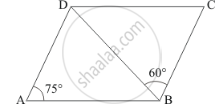
The following statement are true and false .
In a parallelogram, the diagonals are equal
The following statement are true and false.
In a parallelogram, the diagonals bisect each other.
The following statement are true and false .
In a parallelogram, the diagonals intersect each other at right angles .
The following statement are true and false .
In any quadrilateral, if a pair of opposite sides is equal, it is a parallelogram.
The following statement are true and false .
If all the angles of a quadrilateral are equal, it is a parallelogram .
The following statement are true and false .
If three sides of a quadrilateral are equal, it is a parallelogram .
The following statement are true and false .
If three angles of a quadrilateral are equal, it is a parallelogram .
The following statement are true and false .
If all the sides of a quadrilateral are equal it is a parallelogram.
In Fig., below, ABCD is a parallelogram in which ∠A = 60°. If the bisectors of ∠A and ∠B meet at P, prove that AD = DP, PC = BC and DC = 2AD.
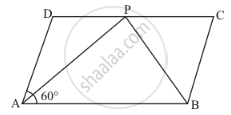
In below fig. ABCD is a parallelogram and E is the mid-point of side B If DE and AB when produced meet at F, prove that AF = 2AB.
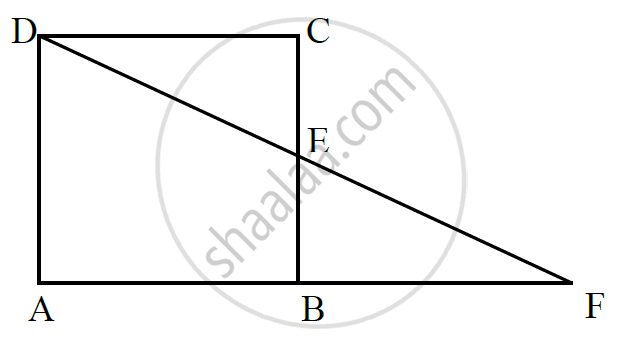
RD Sharma solutions for Mathematics [English] Class 9 13 Quadrilaterals Exercise 13.3 [Pages 42 - 43]
In a parallelogram ABCD, determine the sum of angles ∠C and ∠D .
In a parallelogram ABCD, if `∠`B = 135°, determine the measures of its other angles .
ABCD is a square. AC and BD intersect at O. State the measure of ∠AOB.
ABCD is a rectangle with ∠ABD = 40°. Determine ∠DBC .
The sides AB and CD of a parallelogram ABCD are bisected at E and F. Prove that EBFD is a parallelogram.
P and Q are the points of trisection of the diagonal BD of a parallelogram AB Prove that CQ is parallel to AP. Prove also that AC bisects PQ.
ABCD is a square E, F, G and H are points on AB, BC, CD and DA respectively, such that AE = BF = CG = DH. Prove that EFGH is a square.
ABCD is a rhombus, EABF is a straight line such that EA = AB = BF. Prove that ED and FC when produced meet at right angles
ABCD is a parallelogram, AD is produced to E so that DE = DC and EC produced meets AB produced in F. Prove that BF = BC.
RD Sharma solutions for Mathematics [English] Class 9 13 Quadrilaterals Exercise 13.4 [Pages 62 - 65]
In a ∆ABC, D, E and F are, respectively, the mid-points of BC, CA and AB. If the lengths of side AB, BC and CA are 7 cm, 8 cm and 9 cm, respectively, find the perimeter of ∆DEF.
In a triangle ∠ABC, ∠A = 50°, ∠B = 60° and ∠C = 70°. Find the measures of the angles of
the triangle formed by joining the mid-points of the sides of this triangle.
In a triangle, P, Q and R are the mid-points of sides BC, CA and AB respectively. If AC =
21 cm, BC = 29 cm and AB = 30 cm, find the perimeter of the quadrilateral ARPQ.
In a ΔABC median AD is produced to X such that AD = DX. Prove that ABXC is a
parallelogram.
In a ΔABC, E and F are the mid-points of AC and AB respectively. The altitude AP to BC
intersects FE at Q. Prove that AQ = QP.
In a ΔABC, BM and CN are perpendiculars from B and C respectively on any line passing
through A. If L is the mid-point of BC, prove that ML = NL.
In Fig. below, triangle ABC is right-angled at B. Given that AB = 9 cm, AC = 15 cm and D,
E are the mid-points of the sides AB and AC respectively, calculate
(i) The length of BC (ii) The area of ΔADE.
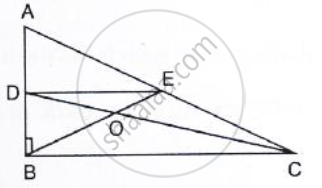
In Fig. below, M, N and P are the mid-points of AB, AC and BC respectively. If MN = 3 cm, NP = 3.5 cm and MP = 2.5 cm, calculate BC, AB and AC.
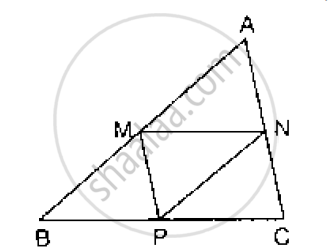
In Fig. below, AB = AC and CP || BA and AP is the bisector of exterior ∠CAD of ΔABC.
Prove that (i) ∠PAC = ∠BCA (ii) ABCP is a parallelogram
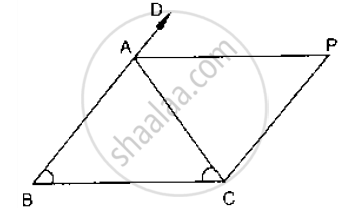
ABCD is a kite having AB = AD and BC = CD. Prove that the figure formed by joining the
mid-points of the sides, in order, is a rectangle.
Let Abc Be an Isosceles Triangle in Which Ab = Ac. If D, E, F Be the Mid-points of the Sides Bc, Ca and a B Respectively, Show that the Segment Ad and Ef Bisect Each Other at Right Angles.
Show that the line segments joining the mid-points of the opposite sides of a quadrilateral
bisect each other.
Fill in the blank to make the following statement correct
The triangle formed by joining the mid-points of the sides of an isosceles triangle is
Fill in the blank to make the following statement correct:
The triangle formed by joining the mid-points of the sides of a right triangle is
Fill in the blank to make the following statement correct:
The figure formed by joining the mid-points of consecutive sides of a quadrilateral is
ABC is a triangle and through A, B, C lines are drawn parallel to BC, CA and AB respectively
intersecting at P, Q and R. Prove that the perimeter of ΔPQR is double the perimeter of
ΔABC
In Fig. below, BE ⊥ AC. AD is any line from A to BC intersecting BE in H. P, Q and R are
respectively the mid-points of AH, AB and BC. Prove that ∠PQR = 90°.

ABC is a triang D is a point on AB such that AD = `1/4` AB and E is a point on AC such that AE = `1/4` AC. Prove that DE = `1/4` BC.
In below Fig, ABCD is a parallelogram in which P is the mid-point of DC and Q is a point on AC such that CQ = `1/4` AC. If PQ produced meets BC at R, prove that R is a mid-point of BC.
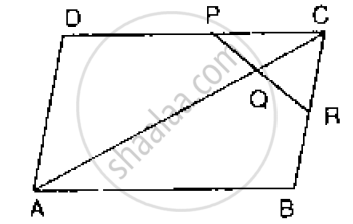
In the below Fig, ABCD and PQRC are rectangles and Q is the mid-point of Prove thaT
i) DP = PC (ii) PR = `1/2` AC
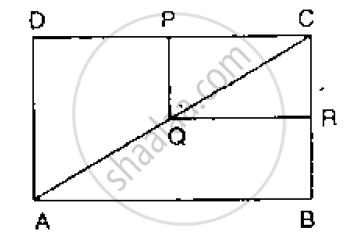
ABCD is a parallelogram, E and F are the mid-points of AB and CD respectively. GH is any line intersecting AD, EF and BC at G, P and H respectively. Prove that GP = PH
BM and CN are perpendiculars to a line passing through the vertex A of a triangle ABC. If
L is the mid-point of BC, prove that LM = LN.
RD Sharma solutions for Mathematics [English] Class 9 13 Quadrilaterals Exercise 13.5 [Pages 68 - 70]
In a parallelogram ABCD, write the sum of angles A and B.
In a parallelogram ABCD, if ∠D = 115°, then write the measure of ∠A.
PQRS is a square such that PR and SQ intersect at O. State the measure of ∠POQ.
If PQRS is a square, then write the measure of ∠SRP.
If ABCD is a rhombus with ∠ABC = 56°, find the measure of ∠ACD.
The perimeter of a parallelogram is 22 cm. If the longer side measures 6.5 cm, what is the measure of shorter side?
If the angles of a quadrilateral are in the ratio 3 : 5 : 9 : 13, then find the measure of the smallest angle.
In a parallelogram ABCD, if ∠A = (3x − 20)°, ∠B = (y + 15)°, ∠C = (x + 40)°, then find the values of xand y.
If measures opposite angles of a parallelogram are (60 − x)° and (3x − 4)°, then find the measures of angles of the parallelogram.
In a parallelogram ABCD, the bisector of ∠A also bisects BC at X. Find AB : AD.
In the given figure, PQRS is an isosceles trapezium. Find x and y.

In the given figure, ABCD is a trapezium. Find the values of x and y.

In the given figure, ABCD and AEFG are two parallelograms. If ∠C = 58°, find ∠F.

Complete the following statement by means of one of those given in brackets against each:
If one pair of opposite sides are equal and parallel, then the figure is ........................
parallelogram
rectangle
trapezium
Complete the following statement by means of one of those given in brackets against each:
If in a quadrilateral only one pair of opposite sides are parallel, the quadrilateral is ................
square
rectangle
trapezium
Complete the following statement by means of one of those given in brackets against each:
A line drawn from the mid-point of one side of a triangle .............. another side intersects the third side at its mid-point.
perpendicular to parallel to
to meet
Complete the following statement by means of one of those given in brackets against each:
If one angle of a parallelogram is a right angle, then it is necessarily a .................
rectangle
square
rhombus
Complete the following statement by means of one of those given in brackets against each:
Consecutive angles of a parallelogram are ...................
supplementary
complementary
Complete the following statement by means of one of those given in brackets against each:
If both pairs of opposite sides of a quadrilateral are equal, then it is necessarily a ...............
rectangle
parallelogram
rhombus
Complete the following statement by means of one of those given in brackets against each:
If opposite angles of a quadrilateral are equal, then it is necessarily a ....................
parallelogram
rhombus
rectangle
Complete the following statement by means of one of those given in brackets against each:
f consecutive sides of a parallelogram are equal, then it is necessarily a ..................
kite
rhombus
square
In a quadrilateral ABCD, bisectors of angles A and B intersect at O such that ∠AOB = 75°, then write the value of ∠C + ∠D.
The diagonals of a rectangle ABCD meet at O, If ∠BOC = 44°, find ∠OAD.
If ABCD is a rectangle with ∠BAC = 32°, find the measure of ∠DBC.
If the bisectors of two adjacent angles A and B of a quadrilateral ABCD intersect at a point O such that ∠C + ∠D = k ∠AOB, then find the value of k.
In the given figure, PQRS is a rhombus in which the diagonal PR is produced to T. If ∠SRT = 152°, find x, y and z.

In the given figure, ABCD is a rectangle in which diagonal AC is produced to E. If ∠ECD = 146°, find ∠AOB.
RD Sharma solutions for Mathematics [English] Class 9 13 Quadrilaterals Exercise 13.6 [Pages 70 - 73]
Mark the correct alternative in each of the following:
The opposite sides of a quadrilateral have
no common point
one common point
two common points
infinitely many common points
The consecutive sides of a quadrilateral have
no common point
one common point
two common points
infinitely many common points
PQRS is a quadrilateral, PR and QS intersect each other at O. In which of the following case, PQRS is a parallelogram?
∠P = 100°, ∠Q = 80°, ∠R = 95°
PQRS is a quadrilateral, PR and QS intersect each other at O. In which of the following case, PQRS is a parallelogram?
∠P =85°, ∠Q = 85°, ∠R = 95°
PQRS is a quadrilateral, PR and QS intersect each other at O. In which of the following case, PQRS is a parallelogram?
PQ = 7 cm, QR = 7 cm, RS = 8 cm, SP = 8 cm
PQRS is a quadrilateral, PR and QS intersect each other at O. In which of the following case, PQRS is a parallelogram?
OP = 6.5 cm, OQ = 6.5 cm, OR = 5.2 cm, OS = 5.2 cm
Which of the following quadrilateral is not a rhombus?
All four sides are equal
Diagonals bisect each other
Diagonals bisect opposite angles
One angle between the diagonals is 60°
Diagonals necessarily bisect opposite angles in a
rectangle
parallelogram
isosceles trapezium
square
The two diagonals are equal in a
parallelogram
rhombus
rectangle
trapezium
We get a rhombus by joining the mid-points of the sides of a
parallelogram
rhombus
rectangle
triangle
The bisectors of any two adjacent angles of a parallelogram intersect at
30°
45°
60°
90°
The bisectors of the angle of a parallelogram enclose a
parallelogram
rhombus
rectangle
square
The figure formed by joining the mid-points of the adjacent sides of a quadrilateral is a
parallelogram
rectangle
square
rhombus
The figure formed by joining the mid-points of the adjacent sides of a rectangle is a
square
rhombus
trapezium
none of these
The figure formed by joining the mid-points of the adjacent sides of a rhombus is a
square
rectangle
trapezium
none of these
The figure formed by joining the mid-points of the adjacent sides of a square is a
rhombus
square
rectangle
parallelogram
The figure formed by joining the mid-points of the adjacent sides of a parallelogram is a
rectangle
parallelogram
rhombus
square
If one angle of a parallelogram is 24° less than twice the smallest angle, then the measure of the largest angle of the parallelogram is
176°
68°
112°
102°
In a parallelogram ABCD, if ∠DAB = 75° and ∠DBC = 60°, then ∠BDC =
75°
60°
45°
55°
ABCD is a parallelogram and E and F are the centroids of triangles ABD and BCDrespectively, then EF =
AE
BE
CE
DE
ABCD is a parallelogram, M is the mid-point of BD and BM bisects ∠B. Then ∠AMB =
45°
60°
90°
75°
If an angle of a parallelogram is two-third of its adjacent angle, the smallest angle of the parallelogram is
108°
54°
72°
81°
If the degree measures of the angles of quadrilateral are 4x, 7x, 9x and 10x, what is the sum of the measures of the smallest angle and largest angle?
140°
150°
168°
180°
If the diagonals of a rhombus are 18 cm and 24 cm respectively, then its side is equal to
16 cm
15 cm
20 cm
17 cm
ABCD is a parallelogram in which diagonal AC bisects ∠BAD. If ∠BAC = 35°, then ∠ABC =
70°
110°
90°
120°
In a rhombus ABCD, if ∠ACB = 40°, then ∠ADB =
70°
45°
50°
60°
In ΔABC, ∠A = 30°, ∠B = 40° and ∠C = 110°. The angles of the triangle formed by joining the mid-points of the sides of this triangle are
70°, 70°, 40°
60°, 40°, 80°
30°, 40°, 110°
60°, 70°, 50°
The diagonals of a parallelogram ABCD intersect at O. If ∠BOC = 90° and ∠BDC = 50°, then ∠OAB =
40°
50°
10°
90°
ABCD is a trapezium in which AB || DC. M and N are the mid-points of AD and the respectively. If AB = 12 cm, MN = 14 cm, then CD =
10 cm
12 cm
14 cm
16 cm
Diagonals of a quadrilateral ABCD bisect each other. If ∠A= 45°, then ∠B =
115°
120°
125°
135°
P is the mid-point of side BC of a parallelogram ABCD such that ∠BAP = ∠DAP. If AD = 10 cm, then CD =
5 cm
6 cm
8 cm
10 cm
In ΔABC, E is the mid-point of median AD such that BE produced meets AC at F. IF AC = 10.5 cm, then AF =
3 cm
3.5 cm
2.5 cm
5 cm
ABCD is a parallelogram and E is the mid-point of BC. DE and AB when produced meet at F. Then, AF =
\[\frac{3}{2}AB\]
2 AB
3 AB
\[\frac{5}{4}AB\]
In a quadrilateral ABCD, ∠A + ∠C is 2 times ∠B + ∠D. If ∠A = 140° and ∠D = 60°, then ∠B=
60°
80°
120°
80°
None of these
The diagonals AC and BD of a rectangle ABCD intersect each other at P. If ∠ABD = 50°, then ∠DPC =
70°
90°
80°
100°
Solutions for 13: Quadrilaterals
![RD Sharma solutions for Mathematics [English] Class 9 chapter 13 - Quadrilaterals RD Sharma solutions for Mathematics [English] Class 9 chapter 13 - Quadrilaterals - Shaalaa.com](/images/8193647912-mathematics-english-class-9_6:1a030933ece146238cec338f12706a07.jpg)
RD Sharma solutions for Mathematics [English] Class 9 chapter 13 - Quadrilaterals
Shaalaa.com has the CBSE Mathematics Mathematics [English] Class 9 CBSE solutions in a manner that help students grasp basic concepts better and faster. The detailed, step-by-step solutions will help you understand the concepts better and clarify any confusion. RD Sharma solutions for Mathematics Mathematics [English] Class 9 CBSE 13 (Quadrilaterals) include all questions with answers and detailed explanations. This will clear students' doubts about questions and improve their application skills while preparing for board exams.
Further, we at Shaalaa.com provide such solutions so students can prepare for written exams. RD Sharma textbook solutions can be a core help for self-study and provide excellent self-help guidance for students.
Concepts covered in Mathematics [English] Class 9 chapter 13 Quadrilaterals are Concept of Quadrilaterals, Properties of a Quadrilateral, Types of Quadrilaterals, Theorem of Midpoints of Two Sides of a Triangle, Property: The Opposite Sides of a Parallelogram Are of Equal Length., Theorem: A Diagonal of a Parallelogram Divides It into Two Congruent Triangles., Theorem : If Each Pair of Opposite Sides of a Quadrilateral is Equal, Then It is a Parallelogram., Property: The Opposite Angles of a Parallelogram Are of Equal Measure., Theorem: If in a Quadrilateral, Each Pair of Opposite Angles is Equal, Then It is a Parallelogram., Property: The diagonals of a parallelogram bisect each other. (at the point of their intersection), Theorem : If the Diagonals of a Quadrilateral Bisect Each Other, Then It is a Parallelogram, Another Condition for a Quadrilateral to Be a Parallelogram.
Using RD Sharma Mathematics [English] Class 9 solutions Quadrilaterals exercise by students is an easy way to prepare for the exams, as they involve solutions arranged chapter-wise and also page-wise. The questions involved in RD Sharma Solutions are essential questions that can be asked in the final exam. Maximum CBSE Mathematics [English] Class 9 students prefer RD Sharma Textbook Solutions to score more in exams.
Get the free view of Chapter 13, Quadrilaterals Mathematics [English] Class 9 additional questions for Mathematics Mathematics [English] Class 9 CBSE, and you can use Shaalaa.com to keep it handy for your exam preparation.
